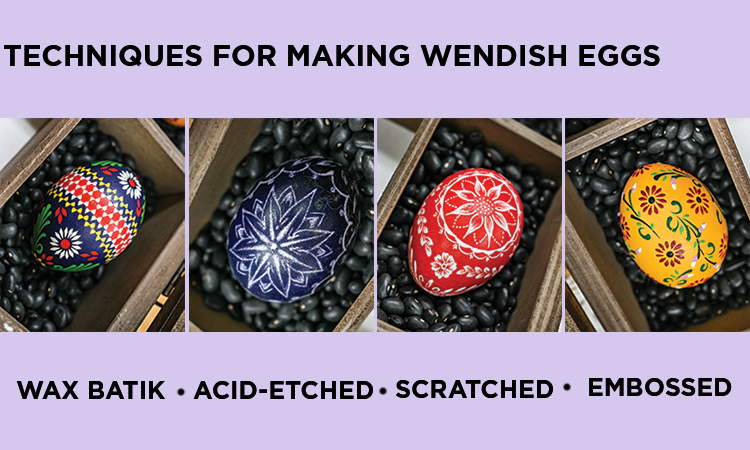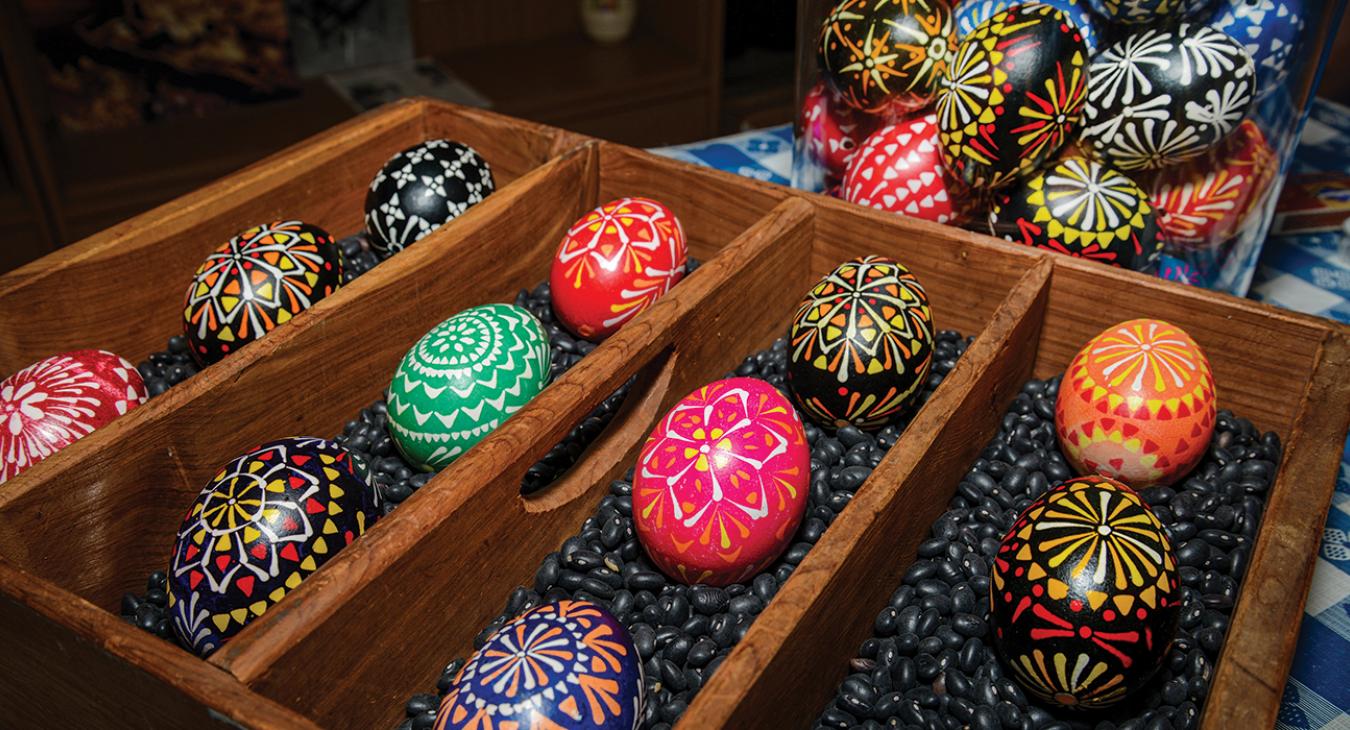Eggs decorated using the wax batik technique, above, on display at Wendish Fest in Serbin in Lee County. The event is hosted every fourth Sunday in September by the Texas Wendish Heritage Society. These eggs were decorated by Susan Unger of Houston.
Story by Clayton Stromberger
With a patient skritch skritch skritch skritch, Sandra Matthijetz slowly moves the tip of a small retractable knife over the shiny surface of an emerald-colored chicken egg. She scrapes off narrow layers of dye, creating concentric oval patterns where the white shell of the egg peeks through.
“You just keep working at it,” Matthijetz says of her freehand creation. A dyed chicken egg is a small canvas with no eraser, which means she has to cheerfully incorporate any slips of the scratching tool. “Sometimes you start a design and something goes haywire, so then you have to come up with a new design.” She laughs and gently continues scraping, steadying the egg in her left hand.
Matthijetz, 74, is fashioning a unique Easter egg at the Texas Wendish Heritage Museum in Serbin. She is carrying on a rich tradition that her Wendish ancestors brought with them to southern Lee County in Central Texas more than a century and a half ago. The Wends, or Sorbs as they are known in Central Europe, are a Slavic people who for centuries have lived near the area where the current borders of eastern Germany, Poland and the Czech Republic meet. They have never had their own country, but speak their own language – Wendish, or Sorbian. In the fall of 1854, nearly 600 Wends who sought religious and cultural freedom from what they viewed as repressive measures of the Prussian government left their homes in the Lusatia region of Europe to relocate in Texas. They followed the trail of a small group of Wendish immigrants who arrived in Texas the previous year. This hardy Lutheran congregation eventually formed the community of Serbin — or “Sorbian land” in Wendish — about 6 miles southwest of Giddings.
Eggs are a symbol of new life and renewal throughout the world, and archaeologists have found fragments of decorated ostrich eggs dating back at least 65,000 years. Crafting elaborately designed and colorful eggs for springtime is an ancient Slavic tradition, with slightly varied styles appearing in cultures throughout the region, from the Wends in eastern Germany to Russia. In Wendish culture, decorated eggs are created throughout the year in preparation for Easter, and play a key role in rites of spring, including children’s games and gift giving.
A basket of Wendish eggs can be as breathtaking as a Texas countryside meadow bursting with spring wildflowers — a dazzling array of bright reds, rich yellows, forest greens and indigo blues.
They feature intricate swirls, radiating lines, floral patterns and complex mosaic-like arrangements with multiple layers of dye coloring. No two eggs are alike and each can take hours to create.
Wendish eggs are a significant enough cultural tradition to be on permanent exhibit at the Institute of Texan Cultures, which is part of the University of Texas at San Antonio. The institute’s website includes a photo of a dozen decorated Easter eggs and a video featuring the “anthem of the Lusatian Sorbs,” sung in Sorbian. Go to bit.ly/3uSE7sL to see it.
If you’ve ever spent a spring day tinkering with dyeing Easter eggs, you may appreciate the four basic approaches the Wendish use in this folk art form. Two involve the application of color, and two involve the removal of color to reveal the eggshell.
For layering on color, wax batik is the most common technique. The egg is either “blown” — its contents carefully removed through small holes in each end — or hardboiled. Barnyard eggs are preferred because they are hardier than store-bought eggs.
Clear melted wax is applied in a pattern on the egg, often using the tip of a specially cut feather from a goose, duck or chicken. When dying the egg, colors are added from lightest to darkest. After each color dries, another wax design is added and the next color applied. After all designs and colors are applied, wax is melted over a candle and wiped away with a soft cloth to reveal an egg of multiple designs and colors.
Embossing, another technique for applying color, involves carefully painting the egg with colored wax, which can add a beautiful bead-like effect.
For removing color, the scratch technique involves sharp tools to scrape dye from an eggshell. The acid technique uses sauerkraut juice, vinegar — or, for experienced artisans, diluted muriatic acid — to paint away dye. The method produces a more watery-edged pattern.
Most Wendish decorators use chicken eggs or slightly larger goose eggs, because they’re easy to obtain and handle. In Germany, some Wendish egg artists seek a larger canvas and decorate 6-inch-long ostrich eggs. These prized creations can fetch top dollar each spring at the Easter markets in the Lusatia area of Germany.
Matthijetz was not steeped in Wendish tradition while growing up in the 1950s in Winchester, 10 miles south of Serbin. She was born nearly a century after her ancestors had set down new roots near Rabbs Creek in Fayette County, not far from Giddings. The Wendish language and cultural traditions were fading as the people spread out across Central Texas and assimilated.
The elders in Matthijetz’s family spoke German, so she thought of herself as a descendent of German immigrants. She recalls her grandfather’s brother reading unusual words aloud from a Wendish Bible, and her mother’s aunt creating beautifully decorated eggs at Easter.
“But those eggs were hard boiled, so they didn’t stick around. They got eaten,” she laughs.
Matthijetz left Winchester for big-city life in Houston after graduating from La Grange High School in 1965. She didn’t have many occasions to ponder the ways of the Wends until decades later.
“I didn’t really think of myself as Wendish until the Wendish Museum got started and I became interested in my heritage,” Matthijetz says.
The Texas Wendish Heritage Museum opened in Serbin in 1979. It grew out of the founding of the Wendish Culture Club in 1972 by a group of Lee County women eager to share their heritage at the Texas Folklife Festival in San Antonio. In 1989 the museum began hosting its annual Wendish Fest every fourth Sunday in September, an event that, in pre-pandemic days, would draw up to 2,000 people. The Fest was canceled in 2020 because of the COVID-19 pandemic, but returned in 2021 and is scheduled again for 2022.
As people of Wendish ancestry in Germany learned about the event, some began visiting Texas to see this unique Lone Star hub of their cultural heritage. One Wend, Kornelia Thor of Leipzig, visited in 2000 and then returned each fall throughout the decade to offer egg-decorating demonstrations at the festival. That sparked Matthijetz’s interest.
The two women became good friends, and Matthijetz and her husband Raymond — also from Winchester and a descendant of early Wend settlers — began visiting Thor in Germany. Together they toured the region’s traditional Easter markets, where countless decorated Wendish eggs are sold.
“In Germany, the Wendish people there grow up with this tradition,” Matthijetz says. “At the Easter markets, they have a room where the children are all decorating eggs. The young kids are able to use the hot wax and not get burned.”
Thor’s connection with the Texas Wendish Heritage Museum is still going strong. She decorates and mails about 200 decorated eggs each year to be sold in the gift shop. Chicken eggs are $25 and the larger goose eggs are $40. There are plenty available year-round. There are eggs with traditional patterns as well as some with a Texas twist, such as bluebonnets or an image of the Ben Nevis, the ship that carried the Serbin-area settlers from Liverpool to Galveston in 1854. You can also see Thor’s work on her German website, ostereierladen.com, which is German for “Easter egg shop.”
For those interested in trying out this Wendish tradition, the museum in Serbin sells a $31 egg-decorating kit with some basic tools and includes a copy of the small, self-printed book, “The Art of Decorating Wendish Easter Eggs,” by Daphne Dalton Garrett. Garrett, who was a longtime resident of Warda just southeast of Serbin, did much to revive Wendish cultural traditions in the area before she died in 2001. The museum also brings in Matthijetz for an egg-decorating workshop when enough people are interested; contact the museum for more information.
Matthijetz and her husband moved back to Winchester in 1998 after she retired from her career as an administrative assistant at a Houston manufacturing firm. To folks at the museum in Serbin, she is a local treasure — always ready to dress in a traditional Sorbian folk costume and share her passion for this unique living connection to another time and place.
“It’s important for the tradition of the eggs to continue so that we have a link back to our ancestors,” says Marian Wiederhold, an area resident of Wendish ancestry and longtime museum librarian and docent. She and Matthijetz are fourth cousins.
Matthijetz may be among the only practitioners of the folk art tradition of Easter egg decorating still living in the Serbin area. She is eager to do what she can to keep the storied tradition rolling on in this area where her ancestors first experienced a Texas springtime.

WAX BATIK
Texas Wends’ most common technique; delicate wax design applied to egg using trimmed tip of feather or head of straight pin (color doesn't adhere to waxed areas); wax dries and egg is dyed with lightest color; egg dries, second wax design applied and egg dyed again in slightly darker color; design continues until final darkest dye; wax melted with candle and wiped away.
ACID-ETCHED
Artist's pen with stainless steel fine point is filled with 50% muriatic acid/50% water; design drawn on dyed egg to expose white shell; in the past, sauerkraut juice or vinegar were used, but muriatic acid mix is preferred now; best technique for creating quick, clear designs.
SCRATCHED
Made by scratching away color from a dyed egg using a small, sharp instrument, such as a nail or thin tip of a knife; a slow process that carries risks because too much pressure by the decorator can puncture egg.
EMBOSSED
Similar to wax batik method except colored wax (pure beeswax is preferred) is painted onto an egg and is not removed after egg is dyed.
Learn to speak a little Wendish
The Wends are a Slavic people from East Germany near Bautzen and Cottbus in the upper Spree River valley, an area long known as Lusatia. They have their own language, Sorbian, which is divided into two dialects, Upper Sorbian and Lower Sorbian. The Wends never had an independent nation and were surrounded by Germans. Here are a few words, as taken from the book ‘‘A Practical Grammar of Upper Sorbian (Wendish)’’ by Charles Wukasch. The book is sold at the Wendish museum.
English: Good morning!
Sorbian: Dobre ranje!
Pronounced: DOE-beh RON-yay!
English: Good night
Sorbian: Dobry dżeń
Pronounced: DOE-bray zhen
English: Thank you!
Sorbian: Dźakuju so wam!
Pronounced: JOCK-you-you so wam!
English: Goodbye
Sorbian: Božemje
Pronounced: BOWSHIM-yay
English: Please!
Sorbian: Prošu!
Pronounced: PRO-zue!





